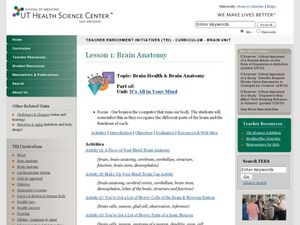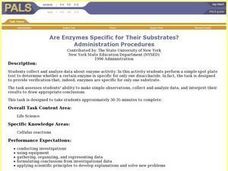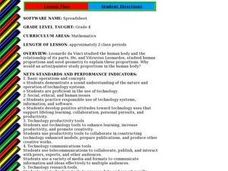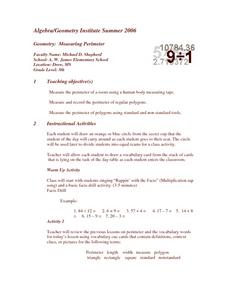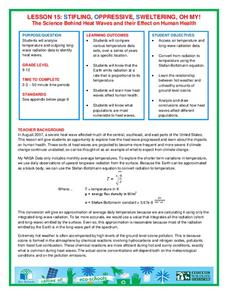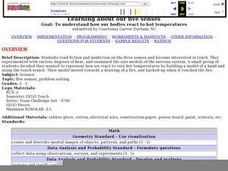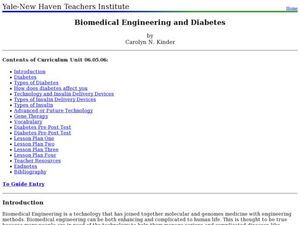Curated OER
Levels of Organization
Middle schoolers read and complete a worksheet about the levels of organization of living things from cells to organ systems. They use a text book and the "Cells R Us" worksheet included to create a metaphor for each of the levels. ...
Curated OER
Brain Anatomy
Students explore the brain. In this brain anatomy lesson, students explore the brain, identify the parts and neurons. They identify nerve pathways involved in daily activities.
Curated OER
Yeast Power!
Students examine how not all microorganisms are bad and that some can actually be beneficial. In this yeast lesson students complete an experiment with yeast and answer questions.
Curated OER
Are Enzymes Specific for Their Substrates?
Students discover enzyme to substrate specificity. The experiment uses samples of glucose and lactose in combination with the enzyme lactase. Students observe the reaction between the lactose and the lactase; the lack of a reaction...
Curated OER
Cardiovascular Fitness
Students design a cardiovascular fitness program that encourages them to implement it in their daily lives.
Curated OER
Oh That Gross Digestive System!
Learners get an understanding of the main components of the digestive system and how the system takes the food we eat and converts it into energy.
Curated OER
Volleyball Work It Out
Students practice volleyball skill-related activities while working on cardiovascular and muscular endurance.
Curated OER
Body Proportion
Fourth graders measure the height and arm span of various classmates. They use a spreadsheet to design a graph that shows the class measurements from tallest to shortest in metric and standard systems.
Curated OER
What is an Organism?
Sixth graders take a pre-test and summarize teacher's discussion of cells, tissues, organs in their notebooks. They read selections on organisms in their textbook and perform a dissection of a chicken drumstick with the thigh attached....
Curated OER
The Circulatory System
Students explore the circulatory system of animals. Using the Internet, students research animals without circulatory systems. They identify the three types of blood vessels and describe the flow of blood through the heart. Finally,...
Curated OER
Digestive System
Students explore the parts of the digestive system. Using interactive spreadsheet software, students observe, name and describe the function of each part of the digestive system. Students may work individually or in pairs.
Curated OER
Exploring the Circulatory System: Getting to the Heart of It All
Seventh graders study how the heart functions and its parts. In this circulatory system lesson students learn how to take their pulse, blood pressure and respiration.
Kenan
Respiratory System
Explore the respiratory system with a model. First, pupils build a set of lungs to experiment how they inflate and deflate. Then, they delve deeper into the topic with a web quest to discover new information about the nose, trachea, and...
Curated OER
Measuring Perimeter
Have your class practice measuring the perimeter of various objects using this resource. Fifth graders place various-sized polygons in order (from largest to smallest). They use non-standard measuring tools to estimate the distance...
National Wildlife Federation
Stifling, Oppressive, Sweltering, Oh My!
Looking for a hot date? Pick any day in August, statistically the hottest month in the United States. The 15th lesson in the series of 21 instructs pupils to investigate the August 2007 heat wave through NASA data, daily temperature...
Curated OER
Learning About Our Five Senses
Students study the sense of touch and various degrees of heat. They design a model that displays how the human hand reacts to heat using a touch sensor.
Curated OER
Kansas Ponds, Lakes & Reservoirs
Learners compare the ponds, lakes, and reservoirs of Kansas. In this geography lesson plan, students use Google Earth to research the different ponds, lakes, and reservoirs in Kansas. Learners will discover that many of the...
Curated OER
Leonardo da Vinci
Students select appropriate tools and technology to perform tests, collect data, and display data. They construct appropriate graphs from data and develop qualitative statements about the relationships between variables.
Curated OER
The Magic School Bus In the Arctic
Learners learn along with Ms. Frizzle's class. In this Magic School Bus lesson plan, students explore how insulation works to keep in body heat.
Curated OER
Mythical Beasts
Students explore literature and art forms containing creatures that are part human and part animal, such as the Greek Sphinx, Neptune, or the Green Centaur. Individually, students write a poem or short story to create a character with...
Curated OER
Bone Relay
Students reinforce their ability to identify bones of the body in a game setting using a Volleyball net, clothes pins, x-rays or pictures of human bones and joints.
Curated OER
Measuring Calories in Food
Students measure the amount of calories in food. In this food energy instructional activity, students discuss what a calorie is, how our bodies use a calorie, and how many we need. Then, students use a calorimeter to calculate the amount...
Curated OER
Biomedical Engineering and Diabetes
Students compare and contrast the three types of diabetes. In this technology lesson, students identify the causes of this disease. They investigate ways to deliver insulin to the body and present their findings in class.
Curated OER
Water Pollution Lesson Plan: All Messed Up
Students map and calculate the area of the school parking lot and then the volume of water falling on the school parking lot. They map the route surface runoff will take to the nearest water body and describe the roles that human...

